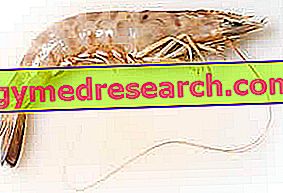Generality
Flea bites worry not so much about the pain and itching they cause, but about the potential diseases that these insects can transmit.

Fleas, in fact, are temporary hematophagous ectoparasites, or particular types of parasites that live on the outer surface of the host feeding on its blood. They can infest both mammals (including humans) and birds and can represent the vector of contagion of various microorganisms responsible for numerous infections. This is precisely the reason why flea bites are so feared and why preventing their infestations (even at home level) is essential.
Although fleas preferentially infest animals, this article will focus primarily on the characteristics and risks associated with flea bites in humans.
Features
What are the characteristics of flea bites?
Flea bites cause small erythemato-pomfoid-type lesions that surround the spot where the flea has bitten the host. Generally, such injuries - however annoying - are small and small.

In some cases, particularly in children, flea bites can cause vesicular type injuries .
An interesting feature of flea bites is their particular disposition. The injuries caused by flea bites, in fact, reflect the movements made by these ectoparasites during their meals and can appear in groups of three or four, or they can be arranged linearly.
Another peculiarity of the lesions caused by flea bites is the disappearance of the redness when pressure is exerted on them.
Fleas can attack humans in any part of the body, but they seem to prefer the lower limbs, which is why, in the vast majority of cases, flea bites are located at the level of the legs, ankles and feet.
Symptoms
Clinical manifestations and symptoms of flea bites
The main symptom induced by flea bites is undoubtedly the itching which can be associated with pain, especially after scratching and continuous rubbing. Sometimes, the area affected by flea bites can have slight or maximum modest swelling. Swelling rarely reaches severe degrees.
Finally, in predisposed and sensitive individuals, the saliva of these insects - inevitably injected into the host during the meal - can cause allergies that manifest themselves with the onset of allergic dermatitis and erythema associated with intense itching .
Possible Complications of Flea Bites
In addition to the potential transmission of pathogens, the continuous scratching and rubbing of lesions caused by flea bites can lead to skin abrasions and wounds, which can lead to infections .
Please note
In the event of further symptoms appearing besides pain and itching and / or pus formation in correspondence with lesions caused by flea bites, it is necessary to contact the doctor immediately. This is because the appearance of "abnormal" symptoms and pus formation could be clear signs of a possible ongoing infection.
Flea Bites in Animals
The symptoms of flea bites in animals are similar to those described for humans. The punctures themselves and the resulting injuries, in fact, can cause pain to the animal and above all very intense itching. Because of this last symptom, the animal is constantly scratching itself with the risk of injuring the skin and favoring possible superinfections.
Moreover, even in susceptible animals there is the possibility of developing allergic reactions (flea allergy dermatitis or DAP).
Transmitted pathogens
Which pathogens can be transmitted through flea bites?
As mentioned, what is most worrying about flea bites are the potential pathogens (bacteria, viruses and parasites) that can be transmitted. Therefore, some of the main microorganisms - responsible for causing disease in humans - that can be transmitted through flea bites will be listed below.
Yersinia pestis
This bacterium affects rodents and is consequently transmitted to fleas that feed on their blood. The beat can then be transmitted from fleas to other rodents or even to humans, causing plague . Fortunately, in Italy, this disease has now been eradicated. However, the aforementioned beating can be transmitted by the bites of rat fleas ( Xenopsylla cheopis ) and humans ( Pulex irritans ).
Rickettsia typhi
Rickettsia typhi is the beat responsible for the onset of murine typhus . The pathogen is usually transmitted to humans by rat flea bites ( Xenopsylla cheopis ).
Francisella tularensis
It is the beat responsible for tularemia, better known as "rabbit fever". Generally, it is transmitted by the bites of the fleas belonging to the genus Spilopsyllus specie cuniculi that infest, in fact, the rabbits.
Bartonella henselae
This beating gives rise to the so-called cat scratch disease, because it is usually transmitted through scratches or bites from domestic or stray cats. However, even fleas can be contagion vectors for this microorganism, both from cat to cat and from cat to human being.
Parasites
Fleas are also vectors of parasites, among which we find those belonging to the genus Hymenolepsis and Dipylidium (in particular, Dipylidium caninum or dog tapeworm). These are flatworms that cause intestinal parasites and are usually transmitted by cat and dog fleas (respectively Ctenocephalides felis and C. canis ) and rat fleas ( Xenopsylla cheopis ) . However, these parasites are not transmitted by flea bites but by their ingestion.
A similar transmission, in the appropriate hygienic conditions, can hardly happen in the man who in order to introduce the parasite in his own intestine should involuntarily eat insects infested by it.
Therefore, the transmission of these flatworms is much more likely in dogs, cats or other animals that tend to bite and lick their fur to clean themselves or to get relief from flea bites.
Treatments and Treatments
Treatments and treatments against flea bites
Flea bites cause painful and itchy lesions which, however, in most cases tend to be self-limited, disappearing over relatively short periods. Eventually, to get relief, it is possible to make ice packs on the lesions.
However, if the wheals or blisters arising from flea bites are particularly annoying, the doctor may decide to prescribe the administration of steroid anti - inflammatories for topical use, such as hydrocortisone- based ointments (Foille Insetti®).
In the case of allergic reactions, however, the doctor may prescribe the administration of antihistamines for topical use, such as, for example, dimethindene (Fenistil gel®) or diphenhydramine (Allergan®).
Cure and Treatments against Infections Transmitted by Flea Bites
Fortunately, the contraction of infections following flea bites does not seem to be a particularly widespread phenomenon in Italy, although such an event cannot be completely ruled out. However, in the event of the appearance of particular symptoms after having found flea bites on your body, it is necessary to immediately contact the doctor who will take care of all the necessary investigations. Generally, the doctor prescribes the execution of appropriate blood tests to highlight the presence of possible infections and pathogens. If successful, the doctor may decide to undertake a prophylactic drug therapy in order to prevent the onset of possible infectious diseases.
In case the patient has already manifested the symptoms of some of the diseases that can potentially be transmitted by flea bites, instead, the doctor will immediately prescribe specific treatments to counteract the responsible pathogen ( antibiotic- based pharmacological therapy and / or antibacterial, antiviral or antiparasitic, possibly associated with supportive and symptomatic therapies).
Prevention
How can you prevent flea bites?
The best way to prevent flea bites is to remove these annoying insects from pets and the home. In this regard, below are some useful tips.
- Since in the home environment, larvae and flea eggs tend to accumulate in animal beds, on carpets, on carpets, on sofas, on beds, etc., in case of suspected infestation, it is necessary to vacuum more sometimes immediately eliminating the bag at the end of the operation. In addition to this, it would be good to wash all the objects at risk at a temperature not lower than 50 ° C. In extreme cases, it may be necessary to contact pest control companies.
- Use appropriate pesticides on your pets. Although similar products can be freely purchased, in order to ensure adequate protection of the animal and to safeguard its health, the choice of the pesticide to be used should be made in agreement with your trusted veterinarian.
- Prevent your pets from coming into contact with beds, sofas, armchairs, etc., in particular, if they spend a lot of time outdoors and are not treated with suitable pesticides.
- Avoid going to places known to be flea-infested with or without your pet.
- Maintain good hygiene in the home by thoroughly and frequently cleaning the potential areas at risk of accumulation of larvae and flea eggs.
- Maintain adequate personal hygiene, in particular, when living with animals.
Notes on Fleas
Fleas are insects belonging to the order of the afanitteri and forming part of the group of temporary hematophagous ectoparasites. This means that they do not live perennially on the skin's surface of the host, but that they attack it when they have to feed on its blood.
Unlike other arthropods of health interest, it is not only female specimens that feed on blood, but also male specimens. Therefore, flea bites are caused by both sexes.
Fleas appear as small insects of variable color from brown to black, without wings and with three pairs of legs thanks to which they can jump from one place to another, or from one guest to another.
Among the species that can attack humans, we mention: Pulex irritans (human flea), Ctenocephalides felis (cat flea), C. canis (dog flea) and Xenopsylla cheopis (rat flea) .
However, fleas that usually infest domestic dogs and cats belong to the genus Ctenocephalides ; therefore, in our areas, most of the flea bites that affect humans are caused by these species.



